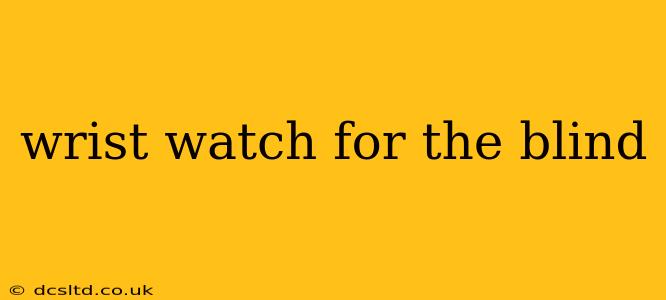Navigating time can be challenging for visually impaired individuals, but advancements in technology have led to the development of innovative wristwatches designed specifically to meet their needs. This guide explores the various types of watches available, their functionalities, and the features that make them accessible and user-friendly.
What are the Different Types of Watches for the Blind?
Several types of watches cater to the needs of blind and visually impaired individuals. These generally fall into two main categories: tactile watches and auditory watches.
Tactile Watches: These watches rely on the sense of touch to tell time. Features often include:
- Raised markers: Clearly defined raised markers on the watch face, representing hours and sometimes minutes. These markers can be numbered or utilize a Braille system.
- Rotating bezel: Some tactile watches utilize a rotating bezel to track elapsed time or set alarms.
- Simplified dials: Often featuring a minimalist design to avoid confusion.
Auditory Watches: These watches use sound to communicate the time. Common features include:
- Voice output: The watch speaks the time aloud, often with the option to select different voice settings or languages.
- Beeps or tones: Simpler auditory watches might use a series of beeps or tones to represent the time. This method generally requires memorizing a specific sequence.
- Haptic feedback: Some models combine auditory cues with subtle vibrations to further enhance time perception.
How Do Watches for the Blind Work?
The functionality of a watch for the blind depends on its design. Tactile watches require users to physically feel the raised markers to determine the time. This necessitates familiarity with the watch's layout and requires some degree of tactile sensitivity.
Auditory watches utilize a variety of mechanisms. Many advanced models employ sophisticated microprocessors to process time and translate it into spoken words. Simpler models might use a more basic electronic system to generate beeps or tones. Haptic feedback systems integrate vibrations, offering an additional sensory layer for time awareness.
What Features Should I Look for in a Watch for the Blind?
When selecting a watch for a blind or visually impaired person, consider these key features:
- Ease of use: The watch should be intuitive and easy to operate without the need for sight. Simple controls and clear feedback mechanisms are vital.
- Durability: A robust and well-built watch is crucial to withstand daily wear and tear.
- Battery life: Long battery life minimizes the inconvenience of frequent charging or battery replacements.
- Adjustability: The ability to adjust settings easily, such as volume or voice, is important for personalized use.
- Water resistance: A suitable level of water resistance protects the watch from accidental splashes or rain.
Are Smartwatches Suitable for the Blind?
Some smartwatches offer accessibility features that can benefit visually impaired users. However, navigating the complex interfaces of many smartwatches can still present challenges. Look for smartwatches with features like:
- Voice control: Enables control of the watch's functions using voice commands.
- Haptic feedback: Provides tactile cues for notifications and interactions.
- Screen reader compatibility: Works seamlessly with screen reader software.
It's crucial to thoroughly research the accessibility features of any smartwatch before purchasing it to ensure compatibility with the user's needs.
Where Can I Find Watches for the Blind?
Specialty retailers selling assistive technology, online marketplaces like Amazon, and some watch manufacturers directly offer watches designed for the visually impaired. It is recommended to research and compare various models before purchasing to ensure the selected watch meets the specific needs and preferences of the user. Consider seeking advice from organizations supporting visually impaired individuals for further guidance.
What is the Price Range for Watches Designed for the Blind?
The price range varies considerably, depending on the features and technology included. Simple tactile watches can be relatively inexpensive, while sophisticated smartwatches with advanced accessibility features may be more costly.
What are the Best Brands of Watches for the Blind?
While specific brand recommendations should be approached with caution (due to ongoing product evolution and individual needs varying greatly), focusing on those known for accessibility features and robust designs is recommended. Thorough research on individual model specifications is paramount.
